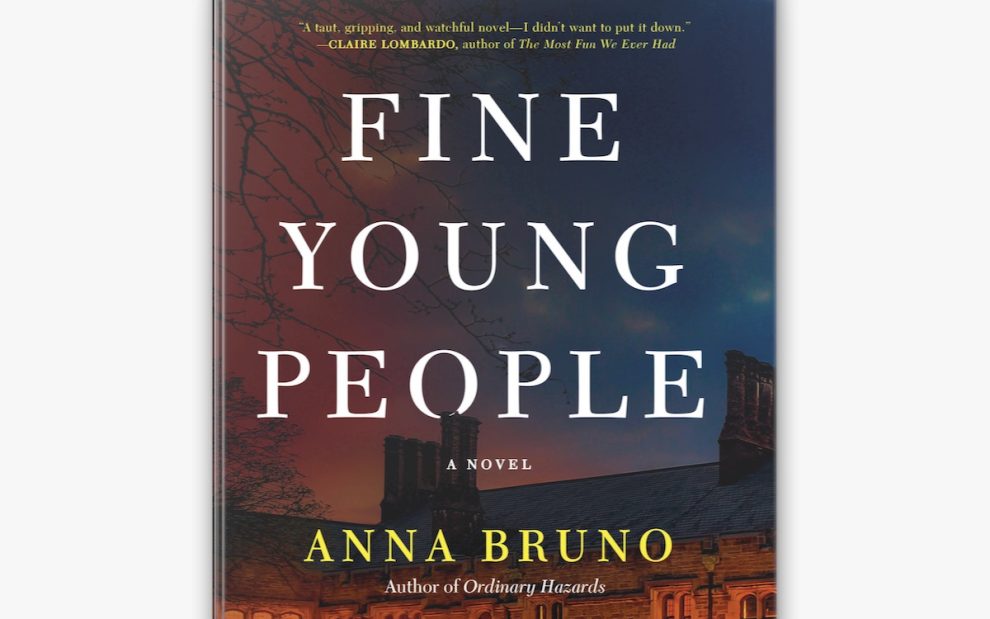When a hockey player at an elite Catholic prep school dies of suicide, leaving a cryptic note referencing the death of another player 20 years earlier, student Frankie Northrup turns her senior journalism project into a private investigation. Along with her best friend, Shiv, she begins asking questions, following threads of evidence that lead to a tangle of corruption and cover-ups—but also to truths about her own identity.
Anna Bruno’s novel Fine Young People (Algonquin Books) is a thoughtful coming-of-age story combined with whodunit combined with campus thriller that explores issues around identity, family, and moral hazard. The story, inspired in part by Bruno’s own experience at a Catholic prep school and set in a wealthy Pittsburgh suburb, artfully weaves an engaging plot with existential questions that take on added significance at a time when the nation’s institutions all seem tilted to favor the wealthy and pampered.
The novel flashes back between third-person accounts of events past and first-person accounts of the protagonist’s investigation. The main character, Frankie, the only child of a lesbian single mother, attends the school as a faculty kid—which places her just enough on the margins of the world she inhabits to be a little more observant, as well as a little more cynical, than many of her peers. Yet she also has the innate optimism of a person whose life has been comfortably free of trauma.
Frankie is headed for Princeton and strangely (for readers whose lives involve more struggle) blase about it—but she’s also aware that her good fortune didn’t magically drop in her lap. It is built into the structure of her elite world, from which most are automatically barred.
The fictional school in the novel, St. Ignatius, is known for its star hockey players, and the institution’s fixation on winning has eclipsed its dedication to Catholic principles and spirituality. Frankie’s mother refers to it as a “spiritual famine.” Reading Bruno’s novel, I was reminded of how schools often treat even mediocre athletics programs as sacrosanct. How many injuries are young people subjected to because their culture’s obsession with sports forces them to put their bodies on the line before they’ve even completed adolescence?
Bruno herself played soccer in high school, while her brother played hockey, and her story is a keen indictment of religious institutions that place winning above their commitment to ethics. According to Bruno, the Catholic school in her story “has come to worship secular gods like the endowment and the hockey team and Ivy League admissions.” But Fine Young People doesn’t just expose the perils of sports idolatry. It shows how privilege corrupts. In this story, it’s the rich and powerful who violate the moral code.
Bruno deconstructs the mythos about the social prizes human beings pursue. “Who are these gods that govern us? Who tricked us into wanting the Ivy League?” Frankie wonders. “What will become of us when we achieve our goals and realize they mean nothing?” It’s a moral revelation that comes wrapped in privilege, but also one our current culture desperately needs.
Despite the story’s critical takedown of the upscale Catholic institution where the events unfold, Bruno’s depiction of Catholicism is surprisingly positive. Frankie’s lesbian mother has a place in the school. Frankie’s philosophy professor, Father Michael, is a compassionate and ethical priest. The story contrasts the corrupt edifice of money and prestige with a more humanist Catholic culture, shaped by gospel values but engaged in the contemporary world. How relatable that culture is may depend on which flavor of Catholicism a reader has experienced.
The novel offers multiple vignettes of Pittsburgh culture and geography: the Cathedral of Learning, Mount Washington, the Three Rivers, even the Hare Krishna commune in neighboring West Virginia. No stranger to the Steel City, I enjoyed the familiar ambience of the novel, but the setting serves a purpose beyond atmospheric texture: Pittsburgh’s rust belt history of income inequality and labor organizing is an excellent stage for a drama about how privilege protects itself.
Frankie sees the lines of connection between the comfortable life of St. Ignatius students and the coal and oil barons who built their estates in Sewickley to “escape the choking pollution of the Steel City.” That the Jesuits constructed their private school in the same area says something about how effectively worldly concerns have been built into the church. St. Ignatius selling out spirituality for hockey could be a metaphor for other sagas in the contemporary church.
Of course, the choking pollution that sickened so many is what made the barons rich. And just as the wealthy families in the past happily ignored the smog and unsafe streets where the working class lived, many connected with St. Ignatius prefer to turn away from any hint of wrongdoing—even murder.
The secrets Frankie unearths demonstrate the corrosive nature of power and prestige. But these secrets are connected with other secrets that highlight humanity’s capacity for nobility, generosity, and love. At the end of Fine Young People, Frankie knows a lot more about who she is and where she came from. But as she ponders her new sense of connectedness, she must grapple, too, with the reality that the good and bad parts of the story she’s found are tangled up with one another. This, too, is a fitting metaphor for the church.
Image: Cover, Fine Young People, by Anna Bruno












Add comment